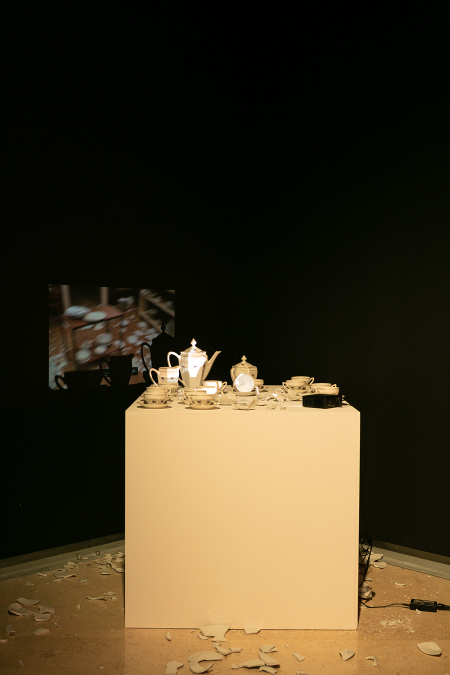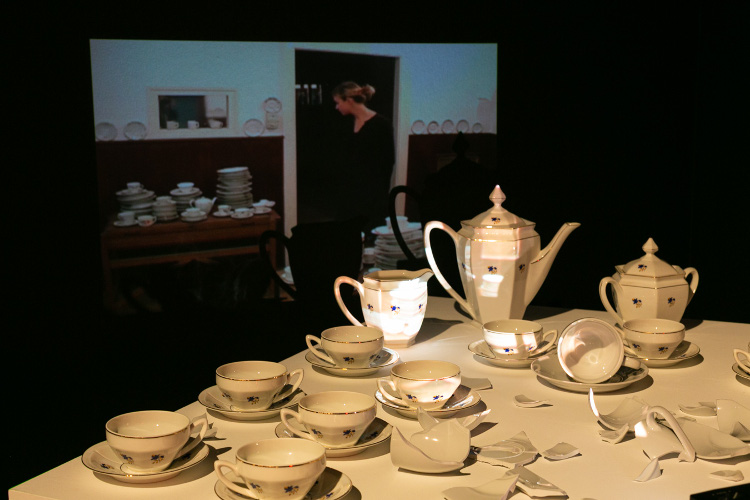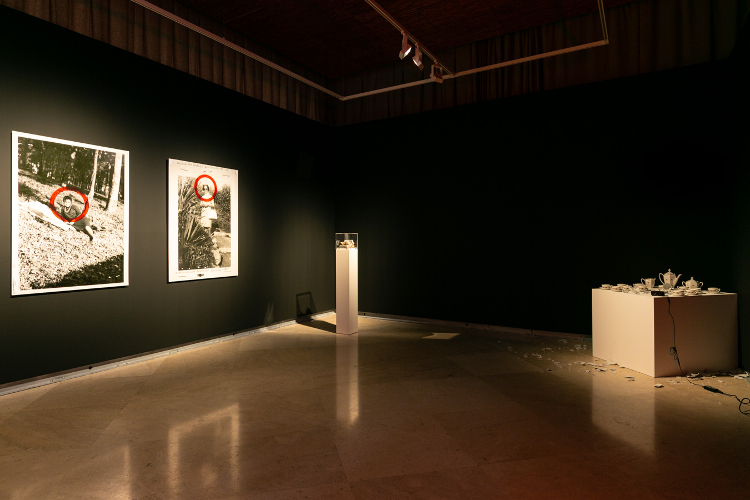
2021
Mit Eleganz und einem feinen Damenschirm, 2004 / 2020
[With elegance and a fine ladylike umbrella]
Video, table, porcelain objects



Katharina Lackner ́s interest in the relationship between
object and viewer can be seen in her displayed piece, Mit
Eleganz und einem feinen Damenschirm (With elegance and a
fine ladylike umbrella) (2004-2020). In this work she uses
porcelain, both whole and broken, to question how we
engage with objects and the power that is held in our
gestures and choices towards them.
Played in reverse, the video cast onto the fallen
teacup shows a woman in an elegant dress adorned
with an umbrella. Moving slowly, she comes into the
space. With grace she lifts the umbrella and smashes the
porcelain that covers the dining room table. When
all the porcelain is smashed she leaves the room. The
original work from Lackner produced in 2004 consisted
of the video installation alone. Now in 2020, the video
reappears in a new context in the collective exhibition
Silence in Pieces. The work brought to us today shows the
evolution of Lackner’s work as the video installation is
now contained within a larger frame of itself. Through
this process, the viewer is invited to engage with a new
perspective concerning subject/object relations. Inspired
by the act of destroying something delicate, this seed of
curiosity prompted Lackner’s interest in porcelain and its
connotations.
Finding that porcelain had long been a traditional gift
for brides, questions of the emotion and power retained
in these objects emerged. Porcelain pieces cannot be
viewed through a simple lens. They are passed down from
generation to generation thus their function and value
serve not just their practical/material use but also as a
mnemonic device for history and tradition. Traditions
are not neutral. Beyond their family specific context
porcelain, according to Lackner ́s research, also symbolizes
femininity and purity. Given away at weddings, its
expensive and delicate nature suggests that you treat it
with care.
As heirlooms such as porcelain move through the
different spacial and temporal phases of a particular
genealogy, they serve to recall a structured remembrance.
Laden with worth, both emotionally and monetarily, these
fragile objects are imbued with power. Like the act of the
wedding itself, the message tied to the ritual is greater
than what can be seen. By this same token, the message
tied to one’s porcelain collection, also takes on a larger
effect. Moving from object to institution the collection
becomes “coextensive with man both in space and time”
and with this, the visible is rendered invisible and the
subject-object divide becomes obscured (Pomian, 1990, 5)
1
.
With the acknowledgment that objects, such as
porcelain, may serve to uphold patterned traditions, do we
truly understand what messages we are transferring?
Are we in charge of them, or them of us?
With the interactive work presented to us here today
we are placed with the opportunity to engage with these
memories and structures, even smash them if you please.
How will you react? In the words of Lackner, “If you could
do what you want, would you do what you want?”
1 Krzysztof Pomian (1990). Collectors and Curiosities: Paris and Venice 1500-1800.
Text: Amalie Alsbo, Lucie Albrecht, Meta Daniel, Sidsel Bjorg Hjelmager